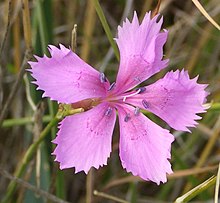Pink (flower)
| Dianthus | |
|---|---|
 |
|
| Dianthus caryophyllus flower | |
| Scientific classification | |
| Kingdom: | Plantae |
| (unranked): | Angiosperms |
| (unranked): | Eudicots |
| (unranked): | Core eudicots |
| Order: | Caryophyllales |
| Family: | Caryophyllaceae |
| Genus: |
Dianthus L. |
| Type species | |
Dianthus is a genus of about 300 species of flowering plants in the family Caryophyllaceae, native mainly to Europe and Asia, with a few species extending south to north Africa, and one species (D. repens) in arctic North America. Common names include carnation (D. caryophyllus), pink (D. plumarius and related species) and sweet william (D. barbatus).
The species are mostly herbaceous perennials, a few are annual or biennial, and some are low subshrubs with woody basal stems. The leaves are opposite, simple, mostly linear and often strongly glaucous grey-green to blue-green. The flowers have five petals, typically with a frilled or pinked margin, and are (in almost all species) pale to dark pink. One species, D. knappii, has yellow flowers with a purple centre. Some species, particularly the perennial pinks, are noted for their strong spicy fragrance.
Hybrids include;
The name Dianthus is from the Greek words Διός Dios ("of Zeus") and ἀνθός anthos ("flower"), and was cited by the Greek botanist Theophrastus. The color pink may be named after the flower, coming from the frilled edge of the flowers: the verb "to pink" dates from the 14th century and means "to decorate with a perforated or punched pattern". As is also demonstrated by the name of "pinking shears", special scissors for cloth that create a zigzag or decorative edge that discourages fraying.
Dianthus species are used as food plants by the larvae of some Lepidoptera species including Cabbage Moth, Double-striped Pug, Large Yellow Underwing and The Lychnis. Also three species of Coleophora case-bearers feed exclusively on Dianthus; C. dianthi, C. dianthivora and C. musculella (which feeds exclusively on D. superbus).
...
Wikipedia
